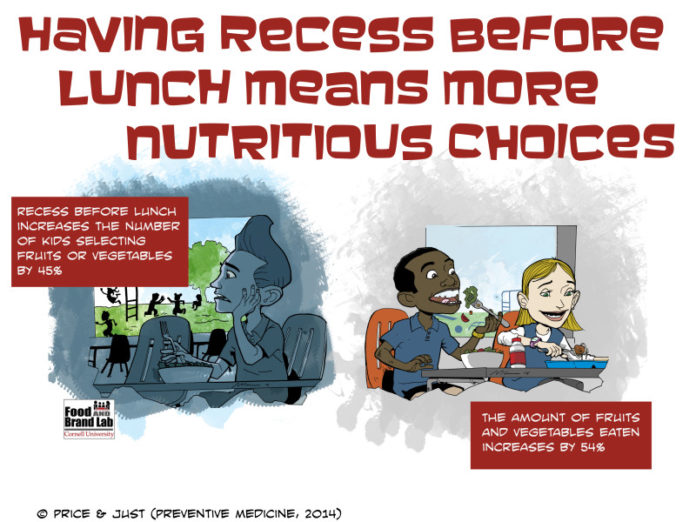
Students participating in the National School Lunch Program are required to select a fruit and a vegetable side. This regulation is intended to get students to eat more fruits and vegetables; however, just because an apple and green beans made it on to the tray doesn’t mean that they will be eaten. Many schools have reported that fruits and vegetables are feeding trash cans rather than students. This new study published in Preventive Medicine shows that one simple no-cost change, holding recess before lunchtime, can increase fruit and vegetable consumption by 54%. “Recess is often held after lunch so children hurry to “finish” so that they can go play — this results in wasted fruits and vegetables,” explains co-author David Just, PhD of Cornell University, “However, we found that if recess is held before lunch, students come to lunch with healthy appetites and less urgency and are more likely to eat their fruits and vegetables.”
Lead author Joseph Price, PhD, Brigham Young University and Dr. Just conducted their study in a school district in Orem, Utah. Seven schools within the district (grades 1-6) participated in the study, three of which switched recess to before lunch and 4 of which continued to hold recess after lunch. For four days in spring of 2011 and 9 days in the fall of 2011 researchers measured fruit and vegetable waste by standing next to the trash cans and recording the number of servings of fruits and vegetables that each student consumed or threw away. They also measured whether or not each student ate at least one serving of fruits or vegetables.
After analyzing a total of 22,939 observations the researchers concluded that in the schools that switched recess to before lunch children ate 54% more fruits and vegetables. There was also a 45% increase in those eating at least one serving of fruits and vegetables. During the same time period consumption of fruits and vegetables actually decreased in the schools that didn’t switch.
Not getting a full, balanced meal can leave children feeling hungry during the rest of the school day leading to decreased academic performance and excessive snacking when they get home from school. The researchers note that, “increased fruit and vegetable consumption in young children can have positive long term health effects. Additionally, decreasing waste of fruits and vegetables is important for schools and districts that are faced with high costs of offering healthier food choices.” Because moving recess is a no-cost way to make kids healthier and make the school meal program more successful, Price and Just recommend that every school makes the switch.
Story Source:
The above story is based on materials provided by Cornell Food & Brand Lab. The original article was written by Katherine Baildon. Note: Materials may be edited for content and length.
Journal Reference:
- Joseph Price, David R. Just. Lunch, recess and nutrition: Responding to time incentives in the cafeteria. Preventive Medicine, 2015; 71: 27 DOI: 10.1016/j.ypmed.2014.11.016
